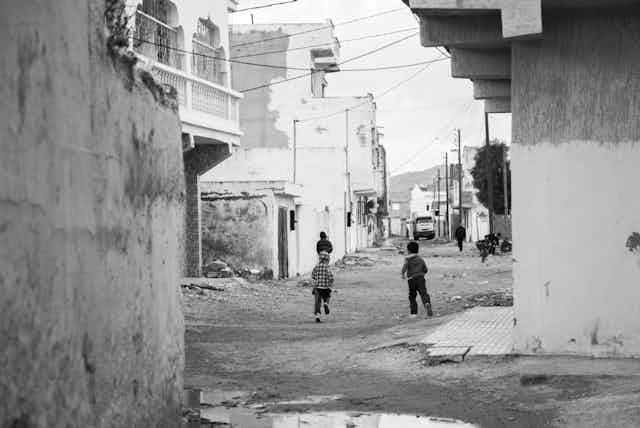In a controversial move, Germany is considering plans to open two reception centres in Morocco for repatriated childen. According to a leaked document of the Federal Office for Migration and Refugees cited by a German newspaper, the centres would have space to receive 200 Moroccan minors and would be run in collaboration with Moroccan non-governmental organisations.
The conditions under which these reception centres would operate have not been specified in detail. But the aim appears to be to allow the government to deport minors without breaching German immigration law. The German Residence Act specifies that in order to deport an unaccompanied foreign minor, the deporting authority must ensure that the minor is either “handed over to a member of his or her family, to a person possessing the right of care and custody or to an appropriate reception centre”.
This plan tallies with German chancellor Angela Merkel’s wider strategy to accelerate the removal of irregular migrants from German territory.
In 2016, Germany and Morocco agreed to collaborate on deporting Moroccan migrants. The German government has also tried to pass a contested law declaring Morocco, Tunisia and Algeria “safe countries of origin” to ease the expulsion of rejected asylum seekers. The law was approved by the German Bundestag, the lower house of parliament, in 2016. But it was then rejected by the upper house, the Bundesrat, in 2017 after opposition parties claimed that arguments to define these countries as “safe” were too weak.

Spain has tried this before
Resorting to reception centres to repatriate Moroccan unaccompanied minors evokes a similar idea launched by Spain in 2005.
Reception centres were meant to accompany the implementation of the memorandum of understanding signed between Morocco and Spain in 2003 over the repatriation of unaccompanied minors. Since the late 1990s, in fact, a flow of Moroccan children has tried to reach Spain by crossing the Gibraltar Strait or by reaching the Spanish enclaves of Ceuta and Melilla.
Between 2005 and 2006, the Community of Madrid launched a project for the creation of two reception centres – one close to Tangier, the other close to Marrakesh – specifically meant to host repatriated unaccompanied children with the financial support of the EU. In 2006, Catalunya promoted a program to accompany minors’ voluntary return to Morocco. The Spanish Development Agency, AECID and Andalucia started two projects in 2006 and 2007, respectively, to build centres for minors’ protection in the north of Morocco and in the region of Tadla Azilal.
Improving the capacity of Morocco’s children’s protection system was meant to prevent children and youths crossing to Spain in the first place. But as in the German case, this was also meant to allow minors to be deported into the centres run by the child protection services of their country of origin, an option provided by Spanish immigration law.
Civil society organisations widely contested Spain’s plan at the time due to its human rights’ limitations. In fact, this strategy was clearly aimed more at ensuring minors’ deportation than at serving their best interests. This ambiguity was even more evident given the poor state of Moroccan care institutions. A 2008 Human Rights Watch report stated that: “The Moroccan child protection system is not ready to provide adequate care for children repatriated from Spain.”
In 2005, the Moroccan branch of UNICEF had officially discouraged Spain from turning to reception centres for repatriated minors. Their report argued that the system was likely to lead to an acceleration of minors’ deportations, without prioritising the well-being of the children.
It is not fully clear how many Moroccan minors have actually been returned from Spain to these reception centres, or if these facilities were ever used for this scope at all. Probably as a result of civil society pressure, the two reception centres promoted by the Community of Madrid were in fact reconverted into structures for the protection of marginalised Moroccan children with an eye over the “prevention of irregular emigration”.
From the late 2000s on, the urgency to link cooperation projects to the deportation of Moroccan children has declined. This was partly due to a cut in the budget of the Spanish Development Cooperation, but also due to internal discussions within Spanish authorities on how to address migration issues through development work. However, in early June 2017, a Spanish politician sought to relaunch the idea of reception facilities during an attempt to resume negotiations with Morocco over the return of Moroccan unaccompanied minors from the Spanish enclave of Melilla. The politician didn’t specify whether the idea would be to open new centres or to use the old ones.
In the interests of the child
As vulnerable people, unaccompanied minors are entitled to rights which make it harder for them to be deported. Article 3 of the Convention on the Rights of the Child – which has been ratified by both Spain and Germany – emphasises that the “interests of the child” should be a primary concern in decisions taken by authorities. There are legitimate doubts about whether deportation enacted through reception centres would breach this convention.
Given the striking similarities between the two cases, Germany should seriously take into account the concerns expressed by civil society organisations over the Spanish case ten years ago. The risk is to criminalise unaccompanied minors as irregular migrants rather than recognising them as children entitled to the right to be protected.

